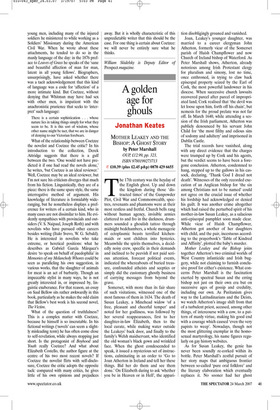A golden age for ghouls
Jonathan Keates
MOTHER LEAKEY AND THE BISHOP: A GHOST STORY by Peter Marshall OUP, £12.99, pp. 323, ISBN 9780199273713 ✆ £10.39 (plus £2.45 p&p) 0870 429 6655 The 17th century was the heyday of the English ghost. Up and down the kingdom during those ‘distracted times’ of the Gunpowder Plot, Civil War and Commonwealth, spectres, revenants and phantoms were at their most restless and fretful. Church bells rang without human agency, invisible armies clattered to and fro in the darkness, drummers sounded a ghoulish tattoo through midnight bedchambers, a whole menagerie of ectoplasmic beasts terrified kitchenmaids or sent children into hysterics. Meanwhile the spirits themselves, a decidedly noisy crew, specific in their demands and inclined to be peevish if not paid serious attention, forecast political events, indicated the whereabouts of buried treasure, confounded atheists and sceptics or simply did the customary ghostly business of carrying messages from beyond the grave.
Somerset, with more than its fair share of such visitations, witnessed one of the most famous of them in 1634. The death of Susan Leakey, a Minehead widow ‘of a free, pleasant and cheerful temper’ and noted for her godliness, was followed by her several reappearances, first to her daughter-in-law Elizabeth, then to the local curate, while making water outside the Leakeys’ back door, and finally to the family’s Welsh maidservant, who identified the old woman’s black gown and wrinkled face. When the ghost condescended to speak, it issued a mysterious set of instructions, culminating in an order to ‘Go to Joan Atherton in Ireland and tell her these things. Bid her do them and see them done.’ On Elizabeth daring to ask ‘whether you be in Heaven or in Hell’, the appari tion disobligingly groaned and vanished.
Joan, Leakey’s younger daughter, was married to a career clergyman John Atherton, formerly vicar of the Somerset parish of Huish Champflower and now Church of Ireland bishop of Waterford. As Peter Marshall shows, Atherton, already notorious among Irish Protestant clergy for pluralism and simony, lost no time, once enthroned, in trying to claw back episcopal property seized by the Earl of Cork, the most powerful landowner in his diocese. When successive church lawsuits recovered parcel after parcel of impropriated land, Cork realised that ‘the devil was let loose upon him, forth off his chain’, but nemesis for the proud prelate was not far off. In March 1640, while attending a session of the Irish parliament, Atherton was publicly denounced by his servant John Child for ‘the most filthy and odious sins of sodomy and adultery’ and imprisoned in Dublin Castle.
The trial records have vanished, along with any direct evidence that the charges were trumped up by Cork and his agents, but the verdict seems to have been a foregone conclusion. Atherton, condemned to hang, stepped up to the gallows in his cassock, declaring, ‘Thank God I dread not death’. Witnesses of the only recorded execution of an Anglican bishop for ‘the sin among Christians not to be named’ could not agree on the crucial issue of whether his lordship had acknowledged or denied his guilt. It was another crime altogether which had raised the perturbed spirit of his mother-in-law Susan Leakey, as a salacious anti-episcopal pamphlet soon made clear. While vicar of Huish Champflower, Atherton got another of her daughters with child, and the pair, incestuous according to the prayerbook’s ‘Table of Kindred and Affinity’, plotted the baby’s murder.
Mother Leakey and the Bishop joins together Atherton’s two criminal worlds of West Country infanticide and Irish buggery, while not claiming to furnish conclusive proof for either’s existence. What concerns Peter Marshall is the fascination exerted by spectral Susan and the erring bishop not just on their own era but on successive ages of gossip and credulity, including our own. As Puritanism gives way to the Latitudinarians and the Deists, we watch Atherton’s image shift from that of a turbulent priest, accused, among other things, of intercourse with a cow, to a pattern of manly virtue, making his good end with a courage which caused ‘even the very papists to weep’. Nowadays, though not the most glittering exemplar in the homosexual martyrology, his name figures regularly on gay history websites.
As for Susan Leakey, the genie has never been soundly re-corked within its bottle. Peter Marshall’s zestful pursuit of her story maps that ambiguous frontier between so-called ‘pure oral folklore’ and the literary elaboration which eventually replaces it. No sooner had her ghost stopped visiting the family than it was being credited with whistling up storms to wreck Minehead merchant vessels. Marshall is surely right in suggesting that Coleridge, whose Rime of the Ancient Mariner was conceived on the Somerset coast, turned her into the nightmare Lifein-Death aboard the phantom ship, who whistles thrice when she wins the fearful dice game. The past, as this shrewdly calibrated, abundantly entertaining study demonstrates, is there for its inheritors to mould and reassemble as they choose, a creative playground rather than a landscape of unalterable truths. Minehead, rather than laying Mother Leakey’s ghost, has named a teashop after her, the ultimate proof of immortality.



















































































 Previous page
Previous page